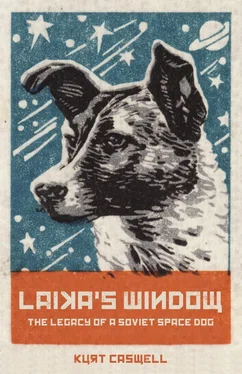¤
After three times around the Earth, the temperature in Laika’s capsule had climbed to 104 degrees Fahrenheit and possibly as high as 109 degrees. Shortly after that, the data from Laika’s sensors stopped coming in. There was no sign of respiration or pulse, no sign of anything except the satellite itself, streaking across the sky, crossing continents in minutes, speeding faster than anything humans had ever built. The Soviets celebrated the Revolution and the state that manufactured it, a miracle really, the satellite, the flight of the first living being in space, the new religion of science and technology that had so elevated the Soviet Union, at least in those days and months, to the status of the greatest nation on Earth.
I have imagined Laika in her capsule speeding around the planet in the mostly dark, the unseen immensity of the cosmos surrounding her. She would have started panting as the temperature rose, a little at first, then heavily as her temperature rose with the temperature of the capsule, her heart rate rising too, her eyes closing with the cooling action of her panting as she struggled to manage the heat. The more she panted, the more she raised the humidity inside the capsule and in turn the temperature, overwhelming the cooling and air regeneration system—a greenhouse effect. She could not move much, seated there in that pod, wires pulled out from beneath her skin, whirling through space. Seated there, her eyes began to close in her growing lethargy, and an agitation too rising in her with the temperature, because as a young dog she still possessed a great deal of energy, and yet she could do nothing about that, nothing to quiet the heat, to end the threat she felt coming on. Her thirst would have been immense. She could not move away from the heat or seek shelter from it, the shade of a tree perhaps or the sanctuary of her home. Perhaps she wanted for some of that space dog food, that gelatinous glob set before her at the feeding tin because it had given her a little relief. But I imagine that her appetite left her as the temperature climbed, and if she had had more food in those last moments, she would not have touched it. All she could do was sit there, her eyes falling heavy and closing, not from the action of her panting now but because she was drifting in and out of a melancholic delirium that settled in, her eyes filling with the flashes of light that come in the darkness in space, and her head no longer in her control, floating on its stem, her paws stretched out before her to the front of the capsule just a few inches from the shores of the universe. Then Laika fell into a coma from which she would never awake. And that was all.
¤
When the team came to understand that Laika was dead only a few hours into her flight, they continued to report on the success of the launch and the satellite. The Soviets had already been criticized for their space dog program, so they remained silent about Laika’s demise. When I asked Sergei Khrushchev why the team had kept Laika’s death secret, he replied, “It was not kept secret. Because we were not publicizing it does not mean it was kept secret. There was not a way to bring the dog back, so it was understood that the dog would be sacrificed for science. No one knew, really, that the capsule had overheated at the time. It was of no interest to anybody to announce that the dog died, but rather to celebrate the launch.” There was no conspiracy here, Khrushchev was telling me, so much as a continued focus on the achievements of Sputnik II . And those achievements were real. Laika was always going to die, so did it matter that she died sooner or later, before or after? The satellite was in orbit, and no nation on Earth had achieved such a towering technological feat except the Soviet Union, and they had now done it twice.
Still, the Soviets were practiced at neglecting to report or even record embarrassing failures. It was policy to demonstrate Soviet power and achievement to the world, as it was policy to do the same in the United States. What benefit was there in offering the long trail of trials and mistakes? “It’s mostly lost now in the enormity of those achievements,” Dubbs told me, “but [Laika’s death] was a failure of technology, or rather of Soviet philosophy. Laika was sacrificed as much for political expedience as for advancing the space program, and the Soviets did not want to advertise their failures.”
The day after the launch, the media reported that the dog—who was still without a name in most countries outside the Soviet Union—was doing fine and might yet be recovered. The next day, November 5, the satellite dominated the news again, with articles speculating about the dog’s return, articles expressing outrage at sending a dog at all, and articles supporting the choice as a necessary step in human spaceflight. Turkina writes in Soviet Space Dogs that Radio Moscow issued this statement to the greater Soviet Union: “Although we are filled with sympathy and sorrow for little Laika, at the same time we cannot divert our attention from the enormous significance of her sacrifice for scientific research.” The announcement does not indicate knowledge of Laika’s death but of her eventual death. It is a call for sympathy and sorrow in preparing the public for that inevitability, at least in the Soviet Union.
Protests broke out in the West. In London members of the National Canine Defense League met with the first secretary of the Soviet Embassy to protest and called for a worldwide daily minute of silence until Laika was returned home. In New York City a picket line formed in front of the United Nations offices. In a telegram to the Soviet Embassy in Washington, DC, an animal adoption group characterized Sputnik II as an atrocity. In Sputnik: The Shock of the Century , Dickson reports that the American Society for the Prevention of Cruelty to Animals deplored using a dog to test a technology that could not “possibly advance human health and welfare.” A New York Times editorial characterized the dog in space as the “shaggiest, lonesomest, saddest dog in all history.” On November 6 an Australian newspaper reported that the dog in the satellite was called Laika.
Soviet scientists were still reporting telemetry signals coming in from Sputnik II as late as November 7, which was in fact true. Laika was dead, but onboard instruments were sending back information about radiation levels and cosmic rays in orbit. On November 10 Sputnik II ’s batteries went flat and all telemetry transmissions ceased. Radio Moscow affirmed this on November 11, and then on November 12 the Soviets announced to the world that Laika was dead.
For the next several decades various Soviet publications offered conflicting accounts of Laika’s death. The Soviets acknowledged that Laika could not have been brought back, and so they had euthanized her quickly, painlessly, humanely. Some sources say that Laika had been fed a poison in her food. Others say a poisonous gas was released into her capsule. Some report she was injected automatically with a poisonous serum. Still other reports had Laika dying of asphyxiation when the oxygen supply in her capsule ran out. These stories faded with time as the world turned to other affairs. Then in 1993, at work on Animals in Space , co-author Colin Burgess met with Oleg Gazenko in Vienna at the Association of Space Explorers congress. In that conversation, Gazenko confirmed that Laika had died “soon after launch” of heat exhaustion.
If the Soviets had developed the technology to return Laika to Earth and made the decision to bring her back when her capsule started heating up, it would have done little good. She would have died anyway. There was not enough time to get her to the ground and release her from the capsule to cool her down. The team had discussed how to deal with a problem like this, how to euthanize Laika by some mechanism they controlled from the ground so that she didn’t suffer. “We had wanted an option to kill Laika,” Seryapin said in Space Dogs . “Laika would be put out of her misery within a few seconds. Some say it was planned that way, but I don’t know. It didn’t happen, and Laika died a slow and painful death that lasted about an hour and a half to two hours.”
Читать дальше












